A regional specialty with 300 years of history from Kagoshima in southern Japan. Traditionally made with yamaimo or jinenjo Japanese yam (Dioscorea japonica), regular rice flour, sugar and water, this simple snow-white cake has a nostalgic sweet taste. Karukan has a supple texture like mochi rice cakes but much lighter and spongy like steamed buns, which seems to make your hand automatically reach for one more piece, and another, and ...
The recipe below features more commonly found nagaimo Chinese yam and an egg white for additional fluffy texture. Plain, white cake without topping is the basic style, yet there are a number of flavor and color variations today.
Whole recipe (approx. 360 g), without kumquat confiture:
676 calories; 12.2 g protein; 1.2 g fat; 152.5 g carbohydrate; 150.9 g net carbs; 70 mg sodium; 0 mg cholesterol; 1.6 g fiber
1 piece (approx. 40 g; 1/9 of recipe), without kumquat confiture:
75 calories; 1.4 g protein; 0.1 g fat; 16.9 g carbohydrate; 16.8 g net carbs; 8 mg sodium; 0 mg cholesterol; 0.2 g fiber
<Ingredients>
(For 15 cm x 14 cm x 4.5 cm rectangular mold)
130-140 g nagaimo Chinese yam (about 100 g after skinning; 135 g with skin in photo)
Water + 1-2 tsp vinegar (to soak peeled nagaimo; not in photo)
100 g white rice flour
60 g granulated sugar
1 egg white
5 tbsp (75 cc) water
9 slices of kinkan kumquat confiture (optional)
<Directions>
1.
Start boiling water for steamer.
Line mold with parchment paper (or lightly grease mold).
2.
Add vinegar to water, and soak peeled nagaimo for 5-10 minutes to prevent discoloration.
3.
Meanwhile, beat egg white.
Add some sugar (1/4 of total amount listed above), and continue beating until peaks form.
4.
Grate nagaimo into suribachi mortar.
Add remaining sugar to nagaimo, and mix well in grinding motion to incorporate air.
(Grated nagaimo has some tint here, as soaking time in vinegar water was a bit too short.)
Add water, and mix well.
Water does not seem to blend well at first, but it will soon incorporate.
5.
Add some meringue, and incorporate by whisking.
Add more, and mix again.
For the last round, transfer to meringue bowl, and mix.
6.
Add rice flour, and mix.
Texture of mixture is somewhat doughy, like muffin batter.
7.
Put in mold, spreading to four corners.
Smooth surface, and place kinkan slices (optional).
8.
Put in steamer, cover, and steam for 20 minutes on medium heat. (Steamer lid is covered with cloth to prevent condensation from dripping onto cake.)
 (Insert skewer to check -- no gooey batter sticks to skewer when done.)
(Insert skewer to check -- no gooey batter sticks to skewer when done.)
9.
Remove from steamer and mold, and cool.
<Notes>
The recipe below features more commonly found nagaimo Chinese yam and an egg white for additional fluffy texture. Plain, white cake without topping is the basic style, yet there are a number of flavor and color variations today.
Whole recipe (approx. 360 g), without kumquat confiture:
676 calories; 12.2 g protein; 1.2 g fat; 152.5 g carbohydrate; 150.9 g net carbs; 70 mg sodium; 0 mg cholesterol; 1.6 g fiber
1 piece (approx. 40 g; 1/9 of recipe), without kumquat confiture:
75 calories; 1.4 g protein; 0.1 g fat; 16.9 g carbohydrate; 16.8 g net carbs; 8 mg sodium; 0 mg cholesterol; 0.2 g fiber
<Ingredients>
130-140 g nagaimo Chinese yam (about 100 g after skinning; 135 g with skin in photo)
Water + 1-2 tsp vinegar (to soak peeled nagaimo; not in photo)
100 g white rice flour
60 g granulated sugar
1 egg white
5 tbsp (75 cc) water
9 slices of kinkan kumquat confiture (optional)
<Directions>
1.
Start boiling water for steamer.
Line mold with parchment paper (or lightly grease mold).
2.
Add vinegar to water, and soak peeled nagaimo for 5-10 minutes to prevent discoloration.
3.
Meanwhile, beat egg white.
Add some sugar (1/4 of total amount listed above), and continue beating until peaks form.
4.
Grate nagaimo into suribachi mortar.
(Grated nagaimo has some tint here, as soaking time in vinegar water was a bit too short.)
Add water, and mix well.
Water does not seem to blend well at first, but it will soon incorporate.
5.
Add some meringue, and incorporate by whisking.
Add more, and mix again.
For the last round, transfer to meringue bowl, and mix.
6.
Add rice flour, and mix.
Texture of mixture is somewhat doughy, like muffin batter.
7.
Put in mold, spreading to four corners.
Smooth surface, and place kinkan slices (optional).
8.
Put in steamer, cover, and steam for 20 minutes on medium heat. (Steamer lid is covered with cloth to prevent condensation from dripping onto cake.)
 (Insert skewer to check -- no gooey batter sticks to skewer when done.)
(Insert skewer to check -- no gooey batter sticks to skewer when done.)9.
Remove from steamer and mold, and cool.
<Notes>
- Completely cool the cake before cutting, and wet knife and wipe with damp cloth between cuts if neatly cut surfaces are desired.
- Instead of egg whites, baking powder is also commonly used to increase fluffiness.
- Kinkan slices can be placed after the cake is steamed. When steamed together, kinkan's taste and aroma penetrates, especially directly below the slice, making the cake somewhat fruity.
- For white rice flour, anything works fine -- karukanko [karukan flour; slightly coarse regular rice flour], joshinko regular rice flour, joyoko fine regular rice flour, or white rice flour from non-Asian grocery stores.
- If using yamaimo or jinenjo, more water needs to be added.
- Proportion of yam, rice flour and sugar is usually about 10:10:5-10 -- the amount is sugar is totally up to you.
- "Karu" in karukan is from karui [light], suggesting the texture.
- Karukan is said to have been created in the late 17th or early 18th century in Satsuma (today's Kagoshima). A menu from 1715 for a Satsuma feudal lord's 50th birthday celebration is the oldest existing record of the cake, which became essential on celebratory occasions among people with privilege. Sugar was a specialty product of Satsuma and a luxury item for a long time, and karukan became common among ordinary people only after the mid-19th century.
- When sweetened bean paste is put in the middle, it is called karukan manju.

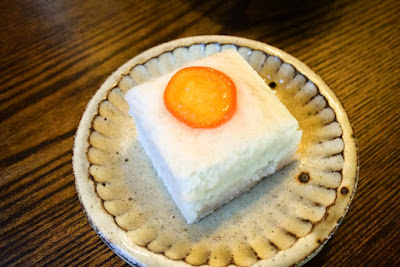

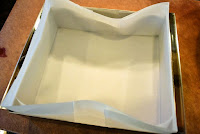
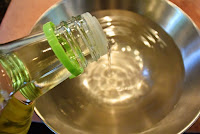
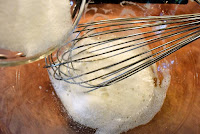
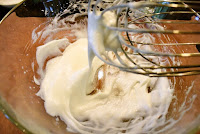

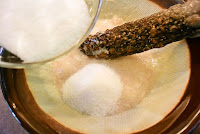

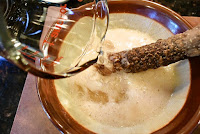
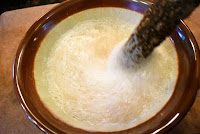
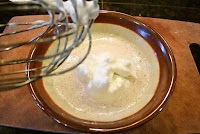
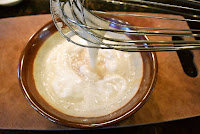
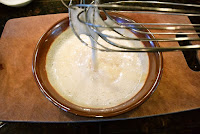
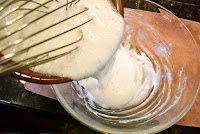
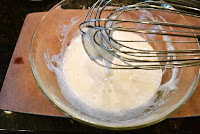
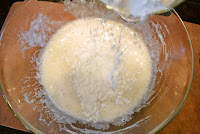
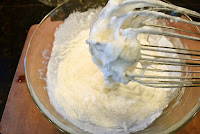
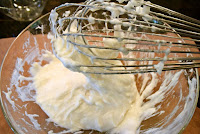
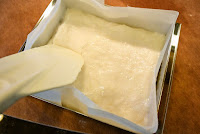
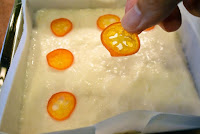
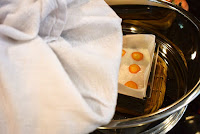
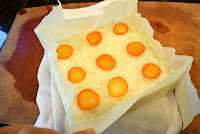
4 comments:
This looks great, I'm always happy about new wagashi recipes. Thank you for this one.
One question: you've stated that "any rice flour works fine": what about shiratamako? I'm really low on joshinko and it's not that easy to get ingredients here; I've got loads of shiratamako, though.
Yes, shiratamako should work too. It might make the cake slightly stickier especially when hot, as shiratamako is made of sweet rice. Some people also use wheat flour when out of any rice flour or to make the texture much lighter.
Hey, in my country (Turkey) sweet potato isn't grow so it is hard to find in markets. What do you suggest i use instead ? Thank you.
Hi, eggs would be a possible substitute, but I do not know they work. If you also add some oil, whole eggs would make this cake something similar to a chiffon cake with slightly heavier texture than a regular one made with cake flour, and using egg whites only would make it something similar to an angel food cake. By the way, nagaimo is not a sweet potato. When fresh, it is crispy and inside is full of sticky fluid (like okra and taro roots), and when grated, nagaimo turns into a gooey and creamy mush. Grated nagaimo fluffs up what you make (pancakes, deep-fried tofu patties, deep-fried/steamed fishcakes, seafood omelet, and so on), and it is often used as an egg-substitute in Japanese vegan dishes.
Post a Comment